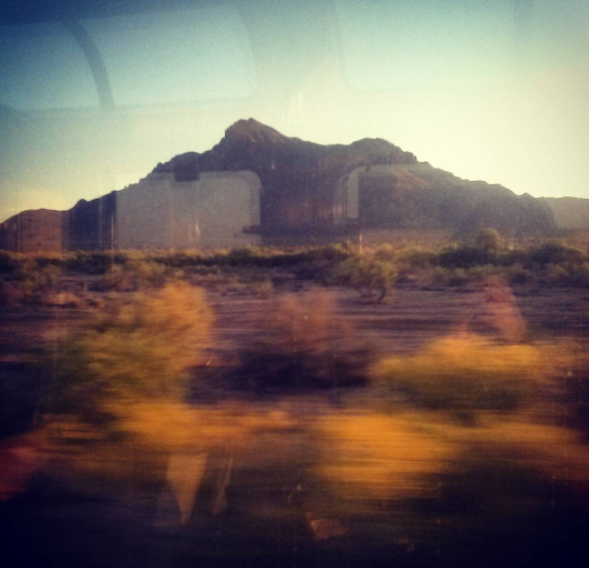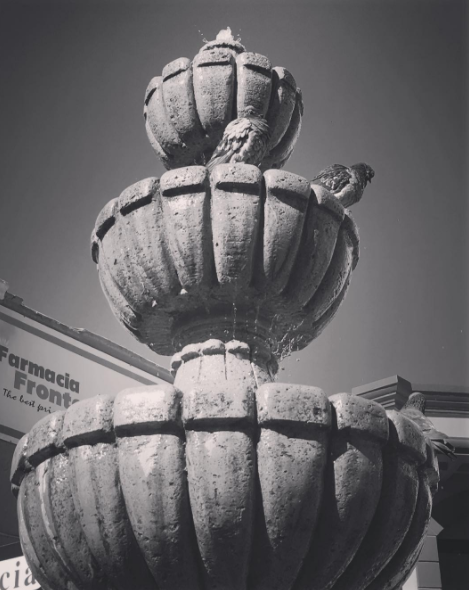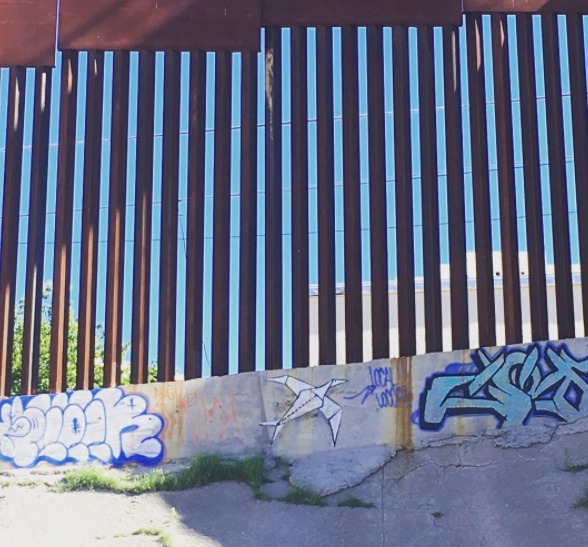 We couldn’t move the desert tortoise off the dirt road because, when those long-living testudinidae are frightened, they void their bladders, stripping themselves of hydration. In the desert, where water is scarce, this puts the tortoises in a deadly position, twenty or fifty or eighty years of life suddenly cut short by a careless human. So the three of us parked before the pull off and accepted that we’d have to walk a half-mile further with beans and blankets strapped to our backs, water gallons in our hands. When we reached the place where the turtle was resting we each bent down and said hello, studying the designs on its drab brown shell, the crags of its head and body.
We couldn’t move the desert tortoise off the dirt road because, when those long-living testudinidae are frightened, they void their bladders, stripping themselves of hydration. In the desert, where water is scarce, this puts the tortoises in a deadly position, twenty or fifty or eighty years of life suddenly cut short by a careless human. So the three of us parked before the pull off and accepted that we’d have to walk a half-mile further with beans and blankets strapped to our backs, water gallons in our hands. When we reached the place where the turtle was resting we each bent down and said hello, studying the designs on its drab brown shell, the crags of its head and body.
It was July 2014, and Carly, Dean and I were in the West Silverbells–a saguaro-studded stretch of desert adjacent to Ironwood National Monument–as part of No Más Muertes, a group that carries food and water into parts of the desert that migrants pass through on their way north. The first year I lived in Tucson, I went on water drops often, hiking through the Altar Valley and the mountain ranges that hug the border with Mexico. I carried supplies into petroglyph-etched canyons and left water on the banks of cattle ponds in hopes that parched travelers, tempted by the bacteria-laden water in the tanks, would find our gallons and drink those instead.
The first thing I noticed about the Sonoran Desert was the stark and stripped down geography, the way the landscape looked like it could have been underwater, as if the shallow sea that once covered southern Arizona had only recently evaporated. I noticed, also, just how alive the desert was–I saw more animals in the first few months of living here than I ever did in the lush, green mountains of New York and Appalachia. In springtime, lizards crawled all over No Más Muertes’ base camp, and at night mapaches visited and tried to break into the cabinets in our tented kitchen, jumping onto the counters and banging pots and pans. A rattlesnake took up residence beneath a storage shed until it was humanely moved and, in the nearby washes, black-tailed jackrabbits and cottontails nibbled on cacti and wild grasses. Occasionally, we’d drive to Ruby to watch the bats. Thousands of chiroptera squat the ghost town’s abandoned mine shaft each summer, leaving at dusk in a funicular stream to hunt for insects and moths.
The desert bustles with human and animal life–border crossers, ranchers, cattle, hawks and gila monsters–but it can also be deadly. Maps produced by border-advocacy group Coalición de Derechos Humanos show red-dot clusters of human remains in places where herds of wild donkeys graze and cactus wrens build their nests. To exist in the borderlands is to exist in a contradiction; this region of abundant life is also a landscape of needless death.
It’s easy, sometimes, to blame the hot, dry desert; to give the Sonoran descriptors like “wasteland” and “hellish,” as if the terrain itself is culpable for the human drama being played out upon it. Certainly it feels like that sometimes, especially, I’m sure, for the undocumented travelers trying to make it to the interior United States, but the desert is also biodiverse and vibrant. It is, for many, home.
In April, I heard the O’odham linguist and poet Ofelia Zepeda speak about the oft-crossed desert, and Tohono O’odham resistance to the border wall. Zepeda said that while people sometimes describe the Sonoran as “harsh,” many O’odham object to that description, because the desert can be nourishing if you know how to live in it. The monsoon rains, she said, by way of example, are good and soft, but they can also be dangerous. As I listened, I thought about the concept of prevention by deterrence–the idea that Border Patrol policing strategies and intensified border security in cities like Nogales and Sasabe are pushing migrants into the most isolated parts of the Sonoran, places where roads, water, and cell service are scarce and death by dehydration is more likely. The desert is not, in and of itself, a cruel place, but in the hands of the powerful and those who do their work, it becomes one. A weaponized landscape.
Zepeda also mentioned that on Tohono O’odham lands–which are split by the border–the line is currently demarcated by vehicle barriers, rather than a fence, to let animals through. If a wall extended across the entirety of the border, it would be a death knell for interborder connectivity, which many of the species in the Sonoran Desert rely on. United States-dwelling jaguars, pygmy owls and big horned sheep–among other species–depend on breeding populations in Mexico to keep their numbers up.
 Zepeda spoke on a Saturday, and that Sunday I took a shuttle from South Tucson to Nogales, where I volunteer at Kino Border Initiative’s Comedor, an aid station for deportees and northbound migrants. I crossed into Mexico at the downtown port of entry and walked through the plaza adjacent to the port, the one that’s lined with pharmacies and souvenir shops frequented by American tourists. There on a colonial-style three-tiered fountain sat three Inca doves. I paused to take a picture and decided that, as I went about my day, I would keep an eye out for animals. I was curious what wild and semi-wild creatures I could find in this urban slice of the borderlands, this split Sonoran city.
Zepeda spoke on a Saturday, and that Sunday I took a shuttle from South Tucson to Nogales, where I volunteer at Kino Border Initiative’s Comedor, an aid station for deportees and northbound migrants. I crossed into Mexico at the downtown port of entry and walked through the plaza adjacent to the port, the one that’s lined with pharmacies and souvenir shops frequented by American tourists. There on a colonial-style three-tiered fountain sat three Inca doves. I paused to take a picture and decided that, as I went about my day, I would keep an eye out for animals. I was curious what wild and semi-wild creatures I could find in this urban slice of the borderlands, this split Sonoran city.
Street dogs glanced at me with begging eyes while I ate refried beans and tamales in La Plaza de los Niños Heroes and followed me as I walked up Calle Reforma towards the Comedor (Nogales’ street dogs have been known to occasionally cross the desert into the United States, attaching themselves to groups of travelers, and a couple have been adopted by friends. Walking around the city, I frequently see their relatives, dogs that look just like floppy, curly-haired Dulce and sweet-faced, jet black Almuerza). Passerines sang in the oak and tila trees at the place where the road bends, and a small girl placed her pet hamster in the driver’s seat of a pink toy car and dragged it around on a string. As I passed the municipal cemetery, its graves adorned with wreaths and bright paper flowers, a lizard scrambled across the sidewalk.
 That afternoon, after I finished my work at the Comedor–I help migrants make phone calls and cash checks issued by US detention centers–I walked back down Calle Reforma. As the road approaches downtown, Reforma becomes Calle Internacional, a relatively sleepy street that runs along the border wall. On the Mexican side, the rust-colored wall is covered in street art and graffiti ranging from quickly painted proclamations of “Chinga la migra” to Paseo de Humanidad, a metal mural by Nogales, Sonora-based Taller Yonke, that depicts travelers made of corn and chilli peppers, hauling washing machines and the dead on their bent backs. Amid this gallery of resistance, there’s one image that’s my favorite, and that I pause in front of each time I pass it: a folded-paper bird.
That afternoon, after I finished my work at the Comedor–I help migrants make phone calls and cash checks issued by US detention centers–I walked back down Calle Reforma. As the road approaches downtown, Reforma becomes Calle Internacional, a relatively sleepy street that runs along the border wall. On the Mexican side, the rust-colored wall is covered in street art and graffiti ranging from quickly painted proclamations of “Chinga la migra” to Paseo de Humanidad, a metal mural by Nogales, Sonora-based Taller Yonke, that depicts travelers made of corn and chilli peppers, hauling washing machines and the dead on their bent backs. Amid this gallery of resistance, there’s one image that’s my favorite, and that I pause in front of each time I pass it: a folded-paper bird.
The paper bird is spray painted onto the concrete below the wall, its creases and folds indicated by solid and stippled lines. It faces north, towards the United States, with outstretched white wings. That bird, symbolic of that desire many undocumented travelers have: to cross into the United States as easily as a thing with feathers (of course, some birds, like the pygmy ferruginous owl, can’t fly over a border wall, and their populations will be further threatened if one is built across the entire border). The bird, made of paper, such a simple material, something you don’t need to be rich or privileged to have.
I took a photograph and uploaded it to my Instagram. I chose a filter that would make the bird stand out, then captioned my post with, “Paper bird spray painted on the Nogales border wall. #noborders”–part of a semi-quixotic commitment to documenting my days in Nogales for the couple hundred people who follow me on the photo sharing app. Then I slipped my phone into my back pocket and walked the rest of the way to the port of entry. I pushed the turnstile and handed my US passport to the customs guard. He glanced at it and waved me through.